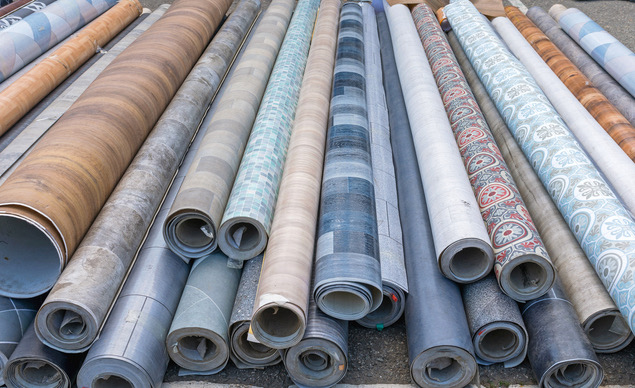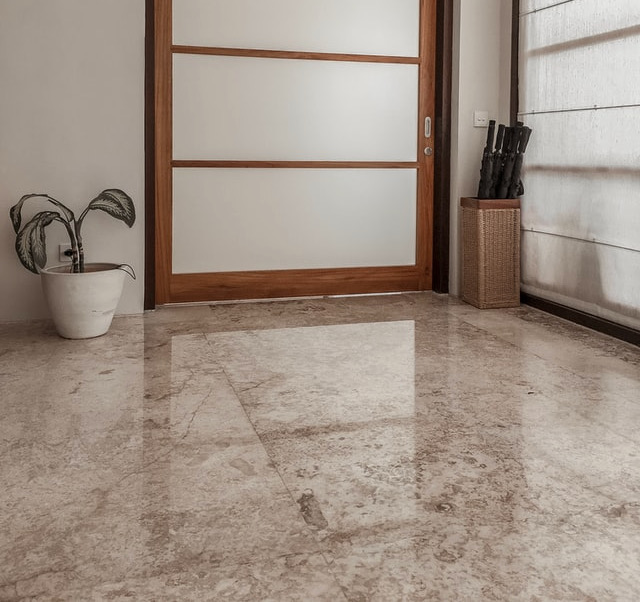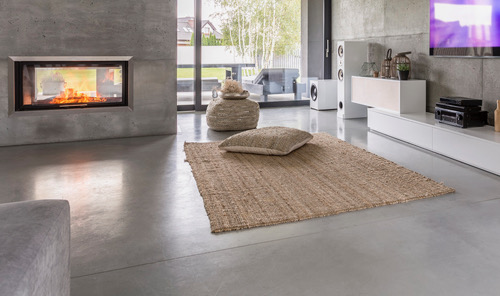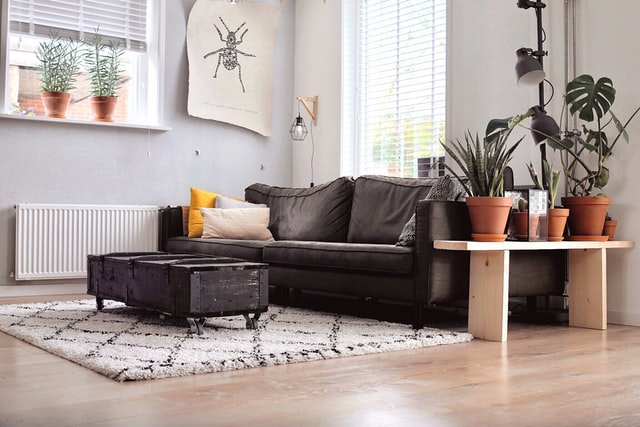With so many flooring options on the market, choosing the right material for your home can be a daunting task. You’ll need to consider various factors, including your budget, lifestyle, typical home activities, and aesthetic preferences. Additionally, some flooring materials are more appropriate for some rooms than others. This guide highlights some of the most popular types of floorings and their advantages so you can pick the right material for your home.
Hardwood

For a traditional and homey appearance, you can’t beat hardwood flooring. Hardwood flooring is the best choice for homeowners who prefer a warm, natural appearance as well as a durable, long-lasting surface. In fact, there are many homes over a century old that still feature their original wooden floorboards. While oak remains the most popular species for hardwood flooring, other choices such as maple, black walnut, and hickory may be worthy of consideration.
Pros and Cons of Hardwood Flooring
Pros:
- Non-toxic
- Boosts home value
- Easy to clean and maintain
- Durable and long-lasting
Cons:
- Unaffordable for smaller budgets
- Prone to dents and scratches
- Susceptible to mold and termites
- Can develop creaking over time
Hardwood Flooring Installation
The good news is that hardwood planks are fairly straightforward to install, particularly if you already have experience in DIY home improvement. Installing the floorboards yourself can save thousands of dollars in labor costs. However, if you lack the skill or experience, you’re better off hiring a pro since small errors may result in gaps and crooked boards.
Hardwood Flooring Cleaning and Maintenance
Hardwood floors require frequent polishing, especially in areas of the home with higher traffic. To clean, simply use a microfiber mop, and cleaning solution formulated explicitly for wooden floors. If vacuuming the floor, take care not to use a brush roll as this may lead to dents and scratches. Depending on the level of use and damage, hardwood floors may occasionally require sanding and refinishing.
Hardwood Flooring Durability
Hardwood floors are designed to withstand heavy use and frequent foot traffic. Unlike carpet, which needs to be replaced every 10 years, hardwood floors can last a lifetime with proper care and maintenance. While finish may need to be redone every decade, but the original boards may well last as long as the home itself.
Laminate

Laminate flooring is a lower-cost, easy-to-install alternative to traditional hardwood flooring. Comprised of different wood-based layers, each laminate board features a photographic imprint on the top layer that mimics real wood’s appearance. This makes laminate flooring the ideal option for homeowners who like the appearance of wood but have a more limited budget.
Pros and Cons of Laminate Flooring
Pros:
- Resistant to humidity damage
- Easy to clean and maintain
- Easy DIY installation
- About half the price of hardwood flooring
Cons:
- Unable to sand and refinish
- May warp due to water spillage
- Shorter lifespan than hardwood
Laminate Flooring Installation
Laminate is the go-to choice for DIY homeowners because it is relatively easy to install, provided the subfloor material is structurally sound. Installation doesn’t require any special knowledge of adhesives or power tools since the boards snap together and rest atop the underlying floor layer. An average homeowner can complete a one-room installation on a weekend. Just be careful not to damage the plank edges when snapping the boards together; this can make the floor more susceptible to water damage from spills.
Laminate Flooring Cleaning and Maintenance
Laminate is easy to clean and care for, but you need to make some special considerations to avoid damage. Water can seep into the cracks and beneath the boards, causing laminate flooring to warp and stain, so stick mainly to sweeping and vacuuming. Use only a flat mop as needed, and be sure the cleaner you use is designed for laminate surfaces.
Laminate Flooring Durability
Unlike hardwood flooring, laminate can’t be refinished, so its lifespan is limited, and unsightly scratches and dents can be difficult or impossible to repair. However, with proper care, laminate flooring can typically last 15 to 25 years. Most laminate is treated with a highly durable top layer that can stand up to foot traffic and sun exposure. However, with proper care and maintenance, laminate flooring may last decades.
Carpet

Carpeting remains one of the most popular flooring options on the market, and for a good reason. Cozy and comfortable, carpeting is the perfect choice if you enjoy hanging out barefoot at home – or just prefer a soft floor to sit on. With a versatile array of textures and designs, homeowners and builders have plenty of great options to choose from.
Pros and Cons of Carpeting
Pros:
- Adds insulation for lower energy bills
- Cozy and comfortable for bare feet
- Extremely affordable
- Reduces sound
Cons:
- Not appropriate for all living areas
- Shows wear and tear
- Requires regular replacement
- Often needs professional cleaning
Carpet Installation
Installing a carpet is difficult for a novice, so for quality results, hire a professional. Carpet installation requires specialized equipment such as tackless strips, knee-kickers, carpet stretchers, and seam rollers. You will also need to know how to properly lay padding and stretch the carpet to avoid lumps and warping.
Carpet Cleaning & Maintenance
Unlike other home flooring options, carpets degrade quickly without regular cleaning and maintenance. You will need to vacuum your carpets at least once a week and possibly more in high-traffic areas. For best results, carpets should be professionally cleaned at least once a year.
Carpet Durability
The biggest downside of carpets is undoubtedly their short lifespan, with most carpets needing replacement after 5 years of regular wear and tear. However, with proper maintenance and a new underlay, you can prolong the life of your carpet by several years. Not all carpets are created equal, so durability is an important consideration to make when choosing your carpet material.
Vinyl

Available in plank, sheet, and tile form, vinyl is one of the most versatile and affordable flooring options. Vinyl flooring is designed to mimic other flooring materials such as hardwood and tile realistically. Vinyl is appropriate for any home area, and its waterproof nature makes it a perfect choice for high-moisture areas such as bathrooms, basements, and kitchens.
Pros and Cons of Vinyl Flooring
Pros:
- Fully resistant to water damage
- Simple DIY installation
- Easy to clean and maintain
- Low cost
Cons:
- Difficult to remove
- May become discolored from sun exposure
- Prone to dents from heavy objects
Vinyl Flooring Installation
Not only is vinyl flooring a fraction of the cost of hardwood, but it’s also incredibly easy to install yourself. This makes it no surprise that vinyl is the most popular flooring options for budget-conscious homeowners. With a few inexpensive tools, a typical vinyl installation project can be accomplished in a single day.
Vinyl Flooring Cleaning and Maintenance
The best way to clean vinyl is to dry mop or vacuum dust and debris from the surface. For periodic deep cleans, use a commercial cleaner designed for vinyl floors – or better yet, a homemade solution of white vinegar and water. Avoid using abrasive scrubs, detergents, and ammonia – these can damage the vinyl flooring and cause unattractive scuffs.
Vinyl Flooring Durability
Vinyl is tough but does require good maintenance practices. Always use sliders or plywood sheets when moving heavy furniture and consider adding mats and rugs in high-traffic areas. As a general rule, thicker vinyl can stand up to more traffic, so keep this in mind when shopping for materials.
Ceramic & Porcelain Tile

With a multitude of colors, shapes, and styles to choose from, ceramic and porcelain tiles are a great way to provide your home with a high-value appearance. As one of the most durable flooring and water-resistant flooring options, tile is ideal for bathrooms, kitchens, and high-traffic areas of the home. While tiles can become cracked and damaged, the good news is that you can easily replace individual pieces, saving you the trouble of ripping up the entire floor.
Pros and Cons of Tile Flooring
Pros:
- Available in many styles and colors
- Rot-resistant
- Increases home’s value
- Does not stain easily
Cons:
- Time-consuming installation
- Cold and hard underfoot
- Prone to cracking and chipping
- High-maintenance grout lines
Tile Flooring Installation
Laying tile is a relatively straightforward process, and one that many homeowners will opt to take on themselves. However, since even slightly crooked tiles can throw off the whole look of a room, you may want to work with a professional for more visible areas of your home. Before jumping into a DIY tile project, keep in mind that tilework is difficult to reverse, so any mistake you make is likely permanent.
Tile Flooring Cleaning and Maintenance
One of the biggest advantages of tile flooring is how easy it is to clean. Because the surfaces are non-absorptive, it’s simple to wipe spills clean with a damp cloth. Feel free to use a mild detergent for a deeper clean. While the tiles themselves are easy to clean and maintain, the grout lines require more care and attention. However, you can usually resolve common issues like stains and mildew buildup with a simple vinegar and water solution.
Tile Flooring Durability
Ceramic and porcelain tiles are considered very durable and can easily stand up to high foot traffic volumes. You will need to check the hardness ratings before purchasing your materials to determine if it’s appropriate for the area where you plan to install it. Tiles are rated on a scale from 1 to 5, with 5 being the hardest and most suitable for heavy traffic. With a proper installation and good grout maintenance, tile floors can easily last a lifetime.
Concrete

Due to its durability and aesthetic flexibility, concrete has surged in popularity in recent years. With endless choices for colors, textures, and finishes, creative homeowners embrace concrete for the visual diversity it offers. Concrete can take far more of a beating than vinyl, tile, and even hardwood, making it an ideal choice for kitchens, bathrooms, and foyers.
Pros and Cons of Concrete Flooring
Pros:
- Flooring costs
- Long lifespan
- Ideal for radiant heat systems
- Moisture resistant
Cons:
- May be slippery when wet
- May develop cracks overtime
- Requires area rugs for warmth and comfort
- Difficult to patch
Concrete Flooring Installation
Concrete flooring requires a more time-consuming installation than carpeting or laminate, but it’s well worth the effort as it is expected to last decades. Concrete installation consists of three phases: surface preparation, decorative treatment, and a topcoat. Pouring, leveling, and texturing concrete is somewhat specialized procedures, so for best results, always hire a professional.
Concrete Flooring Cleaning and Maintenance
No joints, fibers, or grout lines mean concrete is super easy to keep debris clear through regular sweeping. When due for a deep clean, opt for microfiber cleaning pads or mops. Be sure to use a pH-neutral cleaner that won’t react with the concrete and damage the surface. Except for polished concrete, concrete flooring requires sealing or waxing every few months to maintain its looks.
Concrete Flooring Durability
Concrete floors are incredibly resilient to foot traffic and heavy furniture. When properly sealed and maintained, concrete rivals the hardwood’s longevity, boasting a lifespan of more than 100 years. This durability will save you tons of money in the long run. Unlike carpeting, vinyl, and laminates, concrete flooring is pretty much guaranteed to as long as the house.
Home Insurance and Your Flooring Choice
When considering different flooring options for your home, it’s not only essential to think about aesthetics, maintenance, and durability but also to consider how your flooring choice impacts your home insurance. Many homeowners might not realize the type of flooring they opt for can affect their insurance coverage.
Insurance companies often consider the materials used in your home, including the flooring, when determining your insurance premiums. Some flooring types might be more prone to damage from specific perils like water damage, fire, or general wear and tear. For instance, carpets are more susceptible to water damage, which could impact your insurance policy, while fire resistance might be a consideration for materials like hardwood or tiles.
It’s advisable to consult your insurance provider before making a final decision on your flooring. Some companies might offer discounts or adjust premiums based on the materials used in your home, especially if they are more resistant to common hazards.
Here are a few points to consider regarding flooring and insurance:
- Water Resistance: Materials like vinyl and ceramic tiles, which are more water-resistant, might be viewed more favorably by insurance companies as they can withstand water damage better than carpets or hardwood.
- Fire Resistance: Hardwood, concrete, and certain tile types can be more fire-resistant than other materials. This can potentially influence your insurance premiums positively.
- Durability and Maintenance: Floors that require less maintenance and have a longer lifespan may indicate lower risks for insurance providers, potentially affecting your insurance rates.
Remember, the quality of installation and maintenance of your flooring also plays a significant role in risk assessment for insurance. Properly installed and well-maintained floors may contribute to a safer home environment, thus influencing your insurance coverage.
It’s always best to discuss your flooring choices with your insurance agent to understand how it might affect your policy. Making informed decisions not only ensures the aesthetic and practicality of your flooring but also considers the potential impact on your home insurance coverage.
Conclusion
While you may not think about them very much, floors have a significant impact on your life. The type of flooring you choose doesn’t just influence a room’s appearance – it also affects how comfortable and practical certain activities are. When planning your budget don’t forget that you will probably need the help of a handyman for installation, so have it and mind and spend some time choosing the right one for the job. When deciding the best flooring choice, you should also consider your personal tastes, lifestyle, regular home activities, and planning your renovation. This will help you narrow down your choices and select the right material for each room of the house.




